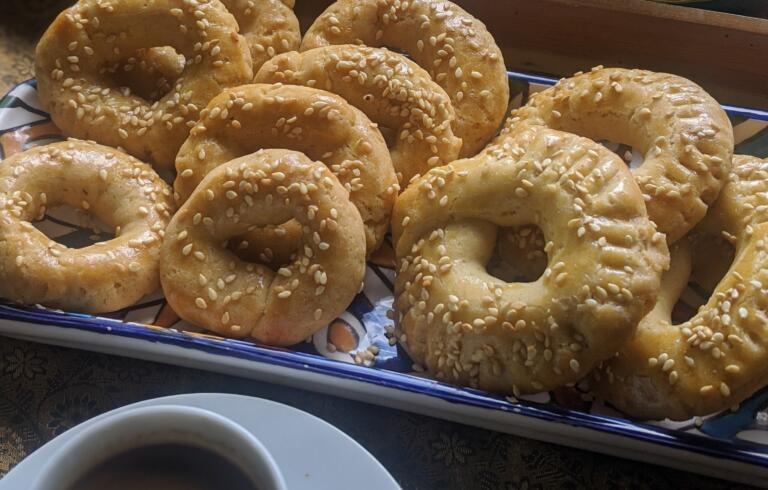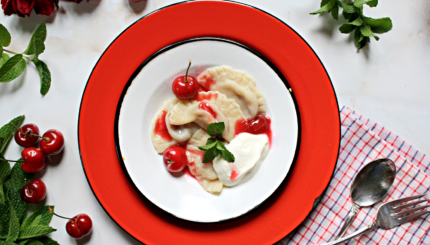Folklore has it that when the Jews were forced to leave Spain in the 15th and 16th centuries, many carried biscochos with them to help sustain them for the journey to new homelands. Biscochos are the beloved Sephardic oil-based cookie, usually shaped into a circle and topped with sesame seeds. But of course, since these simple cookies traveled to many places, there are numerous variations in shape, flavoring and toppings, influenced by local customs and family tradition.
Let’s start with the name, which, like so much Sephardic food, is not consistent. The word “biscocho” comes from Old Spanish, which makes sense since that is the root of the Sephardim’s Ladino language. Like most Jews of Turkish Sephardic heritage, I use that original word that some of my ancestors brought with them centuries ago from Spain. That’s from my Turkish grandfather, but in the town my grandmother was from, Monastir, which is now Bitola in North Macedonia, these cookies were known as “bomboneros.”
In the once-vital Sephardic community of Rhodes, Stella Cohen explains in “Stella’s Sephardic Kitchen” that they were called “reshikas,” shaped like skinny pretzels and twice baked. That is unless the ropes of dough were twisted and shaped into a circle or “bracelet,” which made them “biskotchos.” I have even heard of some families that called the cookies “biscotios.” But don’t be fooled by the word “bizcocho,” which is something entirely different – a sweet, spongy dough that is the basis for many different cakes and sweet breads especially popular in Central and South America.
The shape variations continue. Twisted strands of dough can be left as a straight “stick” instead of made round. Some of the descendants of the Sephardim of Monastir, like the singer Sarah Aroeste (and my partner in our food and music project Savor) make small cuts with a knife around the edges before creating the circles, so the cookie fans out a bit when baked. I learned to leave the strands or ropes smooth when formed into a circle. Toppings, at least, are less variable with traditional sesame seeds or cinnamon-sugar. In the recipe below, there are directions for several options for shaping your biscochos.
The Nosher celebrates the traditions and recipes that have brought Jews together for centuries. Donate today to keep The Nosher's stories and recipes accessible to all.
Whatever they are called and however they are shaped and topped, biscochos are neither sweet like most cookies nor savory, and yet, they are somehow quite habit-forming. The subtle flavor can be from vanilla alone or the addition of anise or almond extract, anise liquor, orange blossom or rose water, or grated rind from a lemon or orange.
Since biscochos store, freeze and travel so well, they are great to keep in a purse, backpack or car just in case. They are a great dunking cookie, perfect with a cup of strong Turkish coffee or mint tea that, for hundreds of years, women would share, along with news and a bit of gossip, in the afternoon when taking a break from all the household work. Even today, many Sephardi women wouldn’t let their homes be without the iconic biscochos for long.
Notes:
- Store in an airtight container, unrefrigerated, for 3 weeks or freeze, well-wrapped, for up to 3 months.
- To crisp biscochos that have softened while stored or frozen, reheat in a 300°F oven for 10-12 minutes.
Biscochos Recipe
These simple, Sephardic oil-based cookies are a culinary classic.
- Total Time: 1 hour-1 hour 15 minutes
- Yield: 4 dozen larger or 6 dozen smaller cookies
Ingredients
For the cookies:
- 5 large eggs, divided
- 1 cup good neutral oil (avocado, sunflower, grapeseed)
- 1 cup sugar
- 1 tsp vanilla extract
- 1 tsp baking powder
- 5–6 cups all-purpose flour
Optional flavoring additions:
- finely grated rind from 1 large orange or lemon
- 1 tsp anise or almond extract
- ½ tsp rose or orange blossom water
For the topping:
- ½–1 cup sesame seeds or ½ cup sugar mixed with 1 Tbsp cinnamon
Instructions
- Preheat oven to 350°F. Cover baking sheets with parchment or spray lightly with oil.
- In a large mixing bowl, whisk together 4 eggs, oil, sugar and optional flavoring additions, if using, until the mixture is lighter in color and getting foamy.
- In a separate bowl, mix baking powder and flour until well blended. Add dry mixture to the egg mixture a little at a time, beating constantly first with a whisk and then with a wooden spoon. Switch to using your hands to mix in flour once the dough is a bit firm to the touch. Use as much of the flour as is needed to create a smooth dough that is pliable, but not sticking to your hands or the surface when rolled. If the dough is too sticky, add a bit more flour. If it gets too crumbly, add a bit more oil.
- Working quickly, make several small balls. For larger biscochos, each ball should be about the size of a large marshmallow or a walnut in the shell (about 1/8 cup). Roll each large ball into a strand or rope 4-5 inches long and about ½-inch wide, about the width of a woman’s finger. For smaller biscochos, make the balls from a slightly overfilled tablespoon of dough and roll each into a strand 2-3 inches long and about 3/8 inches wide.
- For twisted ropes, either left straight or shaped into circles, roll thinner strands.For any size, make each strand smooth and even its entire length. For each shape, make the strands consistent in length by cutting off extra dough and using it for another cookie.
- Shape your cookie with one of the following methods (as you work, place each shaped cookie on the prepared baking sheet about 1 inch apart): 1) Make the circle shape by bringing the ends together or overlapping them slightly. Slightly flatten the strand, then fold in half. Make small cuts, about ½-inch apart on the edge of the strand, then form the circle shape. Create the circle, then make a design around the outside edges by gently pressing a fork. 2) For twists, role strands longer and skinnier. Fold a strand of dough in half and twist the ends in opposite directions. Leave straight or shape into a circle, gently pressing the ends together.
- When all the dough is used, beat the remaining egg well in a bowl. Put sesame seeds and cinnamon-sugar in wide shallow bowls or dishes. Working a few at a time, lightly brush a little egg on top of each biscocho, then sprinkle with topping or dip each cookie in topping of choice. During baking, the biscochos will puff up a little but not spread a lot.
- Bake for 30-35 minutes until lightly golden brown.
Notes
- Store in an airtight container, unrefrigerated, for 3 weeks or freeze, well-wrapped, for up to 3 months.
- To crisp biscochos that have softened while stored or frozen, reheat in a 300°F oven for 10-12 minutes.
- Prep Time: 30-40 minutes
- Cook Time: 30-35 minutes
- Category: Dessert
- Method: Baking
- Cuisine: Sephardic





These look like koulouria, which my Greek Jewish mom used to make when I was young. I wonder if they’re the same thing?
Oddly (or perhaps not), the basic dough recipe is similar to my mother-in-law’s Mandelbread recipe, though stiffer. I am making these today.
My beloved Aunt Mollie (who was born in Poland) used to make these for her husband Jack Baker ( a baker) whose family came from Monastir. She has been gone for over 30 years but I still remember sitting at her kitchen table eating them. Their simple, delicious taste and texture. Food is love and a memory you can not erase.
Love this. I worked in a Sephardic Home for the Aged (cared for all levels) in Brooklyn, NY, I asked one of the residents for recipe for biscochos and wrote it down. It called for a half glass of oil. Long story short, like every good Jewish grandma, the half glass was a yahrzeit glass.